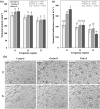Interactive effect of soil moisture content and phosphorus fertilizer form on chickpea growth, photosynthesis, and nutrient uptake
- PMID: 35461340
- PMCID: PMC9035189
- DOI: 10.1038/s41598-022-10703-0
Interactive effect of soil moisture content and phosphorus fertilizer form on chickpea growth, photosynthesis, and nutrient uptake
Abstract
Water shortage and soil nutrient depletion are considered the main factors limiting crops productivity in the Mediterranean region characterized by longer and frequent drought episodes. In this study, we investigated the interactive effects of P fertilizer form and soil moisture conditions on chickpea photosynthetic activity, water and nutrient uptake, and their consequent effects on biomass accumulation and nutrient use efficiency. Two P fertilizer formulas based on orthophosphates (Ortho-P) and polyphosphates (Poly-P) were evaluated under three irrigation regimes (I1: 75% of field capacity, I2: 50% FC and I3: 25% FC), simulating three probable scenarios of soil water content in the Mediterranean climate (adequate water supply, medium, and severe drought stress), and compared to an unfertilized treatment. The experiment was conducted in a spilt-plot design under a drip fertigation system. The results showed significant changes in chickpea phenotypic and physiological traits in response to different P and water supply regimes. Compared with the unfertilized treatment, the stomata density and conductance, chlorophyll content, photosynthesis efficiency, biomass accumulation, and plant nutrient uptake were significantly improved under P drip fertigation. The obtained results suggested that the P fertilizer form and irrigation regime providing chickpea plants with enough P and water, at the early growth stage, increased the stomatal density and conductance, which significantly improved the photosynthetic performance index (PIABS) and P use efficiency (PUE), and consequently biomass accumulation and nutrient uptake. The significant correlations established between leaf stomatal density, PIABS, and PUE supported the above hypothesis. We concluded that the Poly-P fertilizers applied in well-watered conditions (I1) performed the best in terms of chickpea growth improvement, nutrient uptake and use efficiency. However, their effectiveness was greatly reduced under water stress conditions, unlike the Ortho-P form which kept stable positive effects on the studied parameters.
© 2022. The Author(s).
Conflict of interest statement
The authors declare no competing interests.
Figures






References
-
- Ryan J, Sommer R. Soil fertility and crop nutrition research at an international center in the Mediterranean region: Achievements and future perspective. Arch. Agron. Soil Sci. 2012;58:41–54. doi: 10.1080/03650340.2012.693601. - DOI
-
- Sardans J, et al. Long-term drought decreases ecosystem C and nutrient storage in a Mediterranean holm oak forest. Environ. Exp. Bot. 2020;177:104135. doi: 10.1016/j.envexpbot.2020.104135. - DOI
-
- Hessini K, et al. Effect of water stress on growth, osmotic adjustment, cell wall elasticity and water-use efficiency in Spartina alterniflora. Environ. Exp. Bot. 2009;67:312–319. doi: 10.1016/j.envexpbot.2009.06.010. - DOI
Publication types
MeSH terms
Substances
LinkOut - more resources
Full Text Sources
Research Materials
Miscellaneous

